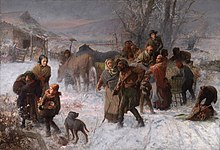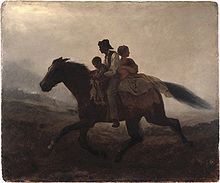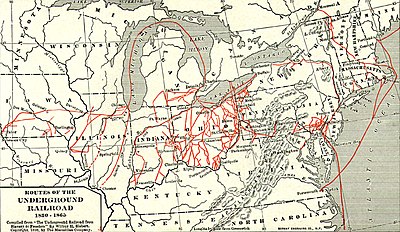Underground Railroad


The Underground Railroad ( English for underground railway was) one of the opponents of slavery - including many whites - existing informal and smuggling network that for black slaves escape from the southern states of the USA in the safer northern states or in the Province of Canada organized. Using secret routes, shelters, with the support of escape helpers and encrypted communication, about 100,000 of them were liberated between 1810 and 1850. The escape aid network, founded in 1780 and known under the name Underground Railroad in the age of railways (from around 1850) , existed until 1862.
development
Escape helper networks for black slaves had been formed in South Carolina and Georgia during the English colonial period . Most of them fled to Florida , which was part of the Spanish colonial empire and where the landowners there promised freedom to anyone who converted to Catholicism . Some of the runaway slaves found shelter among the indigenous Seminoles . After 1790, however, US President Thomas Jefferson put the Spaniards under massive pressure to immediately return escaped slaves to their previous owners. Of the eleven American presidents between 1789 and 1849, seven were slave owners. Initially, the Quaker religious community played a leading role in the liberation of slaves , who first began to bring them to the relatively safe north in an organized manner. With the growth of the abolitionist movement in the northern states, the escape helpers got more and more influx, which eventually led to the foundation of the Underground Railroad. A turning point was the founding of the Boston magazine The Liberator by William Lloyd Garrison in 1831; thereafter the American Anti-Slavery Society comprised more than 250,000 members by 1838. The lively activism of the opponents of slavery alarmed the upper class of the southern states , which saw their economic existence increasingly threatened. Another spark on the way to the American Civil War was the admission of the western border territories as equal states in the Union, as they changed the balance to the disadvantage of the slave-owning states in Congress . In Kansas , therefore, there was a real civil war between opponents and proponents of slavery in the 1850s. When they arrived in the north, the former slaves were not yet completely safe. There was still a high risk of being tracked down, kidnapped and brought back to their "family" by hunters from the south. This practice was also legitimized in the free US states by the Fugitive Slave Law of 1850, but was only used very rarely by the institutions there, which in turn accelerated the secessionist efforts of the southern states even further. Even in the northern states , the black population was largely excluded from equal rights in everyday life . Many therefore moved on to the British Dominion Canada, where the governor there, Sir John Colborne, already in 1829 granted all rights to people of all stripes without restriction. Slavery ended - officially - in the United States with the crushing defeat of the southern states in the Civil War of 1861–1865 and the adoption of the 13th Amendment to the US Constitution by the Lincoln administration.
organization
In the middle of the 19th century, the railroad began its triumphal march across the North American continent and triggered the greatest revolution in the history of mobility in the USA. Since the 1850s, the network of escapees used metaphors from the railway organization to convey messages to the slaves who were determined to flee:
- Conductor or Stationmaster (escape helper),
- Passengers or Cargo (escapes),
- Train (larger group of escaped people),
- Engines (supporters),
- Station or terminal (accommodation / safe house).
After the slaves, e.g. For example, when they had learned the time and place of their escape encoded by chanting, they were usually taken away from their owners' plantations during the night by helpers who also pretended to be slaves . This was u. a. accomplished by means of a horse-drawn carriage with a double bottom. They then found shelter at the stations of the Underground Railroad - inhabited or abandoned houses and barns. (Charles T. Webber's picture may show his farm.) In some cases, these houses had secret passages or camouflaged chambers behind furniture or false wallpaper. The former slave Harriet Jacobs from North Carolina spent seven years in such a chamber before it was possible to take her out of the country by ship. Some of these houses have been restored and opened to the public. After the refugees were out of the reach of the previous owners or the bounty hunters , they were dressed with the help of donations so that they would not be noticed later on their onward journey. The Underground Railroad succeeded in smuggling an estimated 1,000 slaves per year into the northern states or Canada.
Well-known helpers
William Still (1821 (?) - 1902): The African American is often referred to as the "father of the Underground Railroad". Born a free man in New Jersey , he has helped over 800 slaves escape to freedom since the 1850s. He then questioned each of his protégés in detail, documented their biographies and kept them carefully in order to facilitate later family reunification (see also The Underground Railroad ). He himself had only met his brother Peter after he had helped him escape from slavery.
John Rankin (1793–1886): The Presbyterian clergyman was one of the network's first and foremost escape helpers in the state of Ohio . Influential opponents of abolitionism therefore forced him to resign in 1846; However, over a third of his parishioners followed his exit; they later founded the so-called "Free Presbyterian Church". The writer Harriet Beecher Stowe was also heavily influenced by Rankin's work. His daughter Lowry later wrote that Stowe took the fate of a black woman and her baby, whom her father helped flee north in 1838, as a model for her heroine, Eliza, in Uncle Tom's Cabin .
Josiah Henson: An escape helper who had also escaped slavery and was later received in an audience by Queen Victoria of England .
John Brown (1800-1859): One of the most radical advocates and activists of slave liberation, who also worked as a helper for the Underground Railroad. Brown, who was executed in December 1859 after the so-called “Pottawatomie Massacre”, was venerated by many abolitionists as a martyr of their cause. The song John Brown's Body later became a Northern anthem.
Harriet Tubman , (1815/1825? -1913): Undoubtedly the most popular and important member of this escape aid organization. She escaped from slavery at the age of 29, but returned 19 times to the south to help 300 more slaves escape. Tubman, who used the code name “Moses”, was one of the few people who consciously took the risk of being discovered and executed in the process. After the Civil War, she founded a retirement home for former slaves in Auburn, New York .
Martha Coffin Wright (1806–1875): friend of Tubman and feminist; she sheltered escaped slaves in her house in Auburn.
Thomas Garrett (1789–1871): A Quaker , manager of a gas company, and good friend of Tubman. The staunch abolitionist openly ran a station for escaped slaves and their helpers in his house in Delaware . For this he was sentenced in 1848 to a fine of 4,500 dollars, which was very high for the time. According to his own statements, he helped 2,700 people to flee. In Wilmington (Delaware) the Tubman-Garrett Riverfront Park was named after the two escape helpers.
literature
- Harriet Jacobs: Incidents in the Life of a Slave Girl, 1861. In this book, very openly for the time, the sexual exploitation of female slaves by their “masters” is denounced.
- David Walker , 1829, appealed in writing to the residents of Georgia to free the slaves.
- Harriet Beecher Stowe : Uncle Tom's Cabin , 1852.
- Caroline Lee Hentz : The Planter's Northern Bride, 1854.
- Ann Hagedorn: Beyond the River: The Untold Story of the Heroes of the Underground Railroad. Simon & Schuster, New York 2002, ISBN 0-684-87065-7 .
- Michael Burgan, Philip Schwarz: The Underground Railroad. Infobase Publishing, 2006, ISBN 978-1-438-10654-0 .
- Mary Ellen Snodgrass: The Underground Railroad: An Encyclopedia of People, Places, and Operations. Routledge, 2015, ISBN 978-1-317-45415-1 .
- Eric Foner : Gateway to Freedom: The Hidden History of the Underground Railroad. WW Norton & Co, New York 2016, ISBN 978-0-393-35219-1 .
- Colson Whitehead : Underground Railroad. Novel. Carl Hanser Verlag, Munich 2016, ISBN 978-3-446-25655-2 .
- Ronald D. Gerste: With the "Underground Railroad" to freedom. Article in Back then , Volume 52, 5-2020.
Web links
- National Underground Freedom Center, Cincinnati, Ohio, USA
- Underground Railroad on the website of nationalgraphic.com (English)
- Underground Railroad at the Buxton National Museum (English)
- Ole Helmhausen: UNDERGROUND RAILROAD: Canada, promised land article in DER SPIEGEL from July 16, 2004
- The Path to Freedom - The History of the “Underground Railroad” - Article in Talk Together , NO. 6, November / December 2003 ( Memento from September 11, 2009 in the Internet Archive )
Individual evidence
- ↑ www.learnnc.org - the house shown is possibly the painter's farm.
- ↑ This is shown in an article in the New York Times on November 26, 1852.
- ↑ Barley 2020, pp. 72-76; Colborne: “Tell the Republicans on your border line that we royalists don't judge people by their color. When you come to us, you are entitled to the same privileges as all other subjects of His Majesty. "
- ↑ Barley 2020, pp. 72–76.
- ↑ Barley 2020, pp. 72–76.
- ↑ Barley 2020, pp. 72–76.





